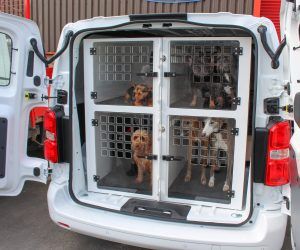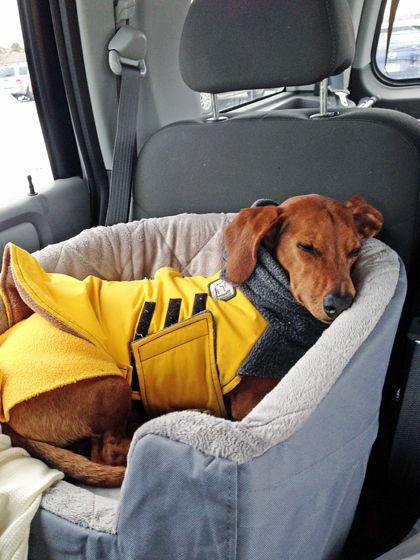Dog / Detail
Taking Your Dog on an Overland Trip by Car: Cage or Free?
Jonathan Bennet | 21 October 2024 | 16:10
Road trips are a fantastic way to explore new places and bond with loved ones. For many dog owners, the idea of including their furry friends in these adventures is incredibly appealing.
However, taking a dog on a car journey comes with its own set of considerations, particularly when it comes to safety and comfort. One of the most significant decisions you'll need to make is whether to use a crate or allow your dog to roam freely in the car.

Crating your dog during a car trip offers several advantages in terms of safety and security.
- Safety in a Crash: In the event of a sudden stop or accident, a properly secured crate can help prevent your dog from being thrown around the vehicle, potentially causing serious injuries. Crates act as a protective barrier, reducing the risk of harm.
- Confinement and Security: Crating can provide a sense of security and comfort for some dogs, especially those prone to anxiety or fear during travel. It creates a familiar and confined space that can help them feel safe and relaxed.
- Prevention of Distractions: By keeping your dog contained in a crate, you can minimize distractions while driving. Dogs can be easily distracted by sights and sounds outside the window, potentially leading to unwanted behaviors like barking or jumping.
- Legal Requirements: In some regions, it may be legally required to transport dogs in a secure crate or carrier while driving. Familiarizing yourself with local regulations is essential to ensure compliance.

If you decide to crate your dog for the journey, it's crucial to select the appropriate size and type of crate. The crate should be large enough for your dog to stand up, sit down, and turn around comfortably. Avoid crates that are too small, as they can cause stress and discomfort.
Additionally, consider the type of crate that best suits your dog's personality and needs. Options include wire crates, plastic crates, and soft-sided carriers.

Addressing Crate Concerns
While crating offers numerous benefits, it's important to acknowledge and address potential concerns:
- Motion Sickness: Some dogs may experience motion sickness while traveling in a car, even when crated. If your dog is prone to vomiting, consult with your veterinarian for advice on managing motion sickness.
- Anxiety and Stress: Crating can be stressful for some dogs, especially those who are not used to it. Gradually introduce your dog to the crate and provide positive reinforcement to create a positive association.
- Limited Mobility: Crating restricts your dog's movement, which can be uncomfortable for long journeys. Plan regular stops to allow your dog to stretch their legs and relieve themselves.
The Case for Free Roaming
While crating is often recommended for safety, some dog owners prefer to allow their dogs to roam freely in the car. This approach can offer certain advantages:
- Increased Comfort and Freedom: Dogs may feel more comfortable and relaxed when they have the freedom to move around the car. This can be particularly beneficial for dogs who suffer from anxiety or claustrophobia.
- Easier Access: Having your dog unrestrained allows for easier access during stops, making it more convenient for potty breaks and playtime.
- Bonding and Interaction: Free roaming can provide opportunities for bonding and interaction between you and your dog during the journey. You can talk to them, play games, or simply enjoy their company.

Safety Considerations for Free Roaming
If you choose to let your dog roam freely, it's essential to prioritize safety:
- Properly Secured Harness or Seatbelt: Ensure your dog is wearing a properly fitted harness or seatbelt to prevent them from being ejected from the car in the event of a collision.
- Secure Storage of Items: Store all loose items in the car to prevent your dog from accessing and ingesting potentially harmful objects.
- Avoid Distractions: Minimize distractions for your dog to prevent them from jumping or barking, which can compromise your driving.
- Supervision: Never leave your dog unattended in the car, as the temperature can rise quickly, even on mild days, leading to heatstroke.
Making the Right Choice
The decision of whether to crate or allow your dog to roam freely during a car trip depends on several factors, including your dog's personality, behavior, and any underlying health conditions. Consider the pros and cons of each approach and choose the option that you believe will provide the safest and most comfortable experience for your furry companion.

- Regardless of whether you choose to crate or allow your dog to roam freely, here are some additional tips for a safe and enjoyable road trip:
- Acclimate Your Dog to Car Rides: Gradually introduce your dog to car rides to help them become comfortable with the experience. Start with short trips and gradually increase the duration.
- Pack Essential Supplies: Bring along plenty of food, water, toys, and a comfortable bedding for your dog. Don't forget any necessary medications or supplies.
Plan Regular Stops: Schedule frequent stops to allow your dog to stretch, relieve themselves, and socialize. - Monitor Your Dog's Behavior: Pay attention to your dog's behavior during the trip. If they exhibit signs of anxiety, stress, or discomfort, adjust your plans accordingly.
- Consult with Your Veterinarian: Before embarking on a road trip, consult with your veterinarian to ensure your dog is healthy enough to travel and to discuss any specific concerns or recommendations.

Related
-

The Healing Power of Dogs: How Canine Therapy is Revolutionizing Mental Health and Boosting Positive Energy in Humans
Dog14 November 2024
-

A Pawsitive History: Dogs of Nuremberg
Dog09 November 2024
-

The Role of Oxytocin in the Human-Dog Bond: The Science Behind Our Deep Connection
Dog06 November 2024
-

Beyond the Beach: Jamaica's Dog Lovers
Dog29 October 2024
-

A Dog's Delights: Homemade Snacks for Our Furry Babies, Recipes Included!
Dog29 October 2024
-

A Dog's Disorientation: Understanding Your Dogs' Wanderlust
Dog29 October 2024
Popular
-

-

A Pawsitive History: Dogs of Nuremberg
09 November 2024 -

-

Beyond the Beach: Jamaica's Dog Lovers
29 October 2024 -
